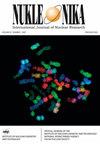Evolution of treatment planning and dose delivery methods during radiotherapy for patients undergoing bone marrow transplantation: a review
IF 0.3
4区 物理与天体物理
Q4 CHEMISTRY, INORGANIC & NUCLEAR
引用次数: 5
Abstract
Abstract Background and objectives: This study describes the treatment planning and dose delivery methods of radiotherapy for patients undergoing bone marrow transplantation. The analysis was carried out in the context of the evolution of these methods over the last 60 years. Materials and methods: A systematic literature search was carried out using the PubMed search engine. Overall, 90 relevant studies were included: 24 general studies, 10 describing isotopes usage, 24 related to conventional and 32 to advanced methods. Results: The analysis of the evolution of radiotherapy methods shows how significantly the precision of dose planning methods and its delivery have changed. The atypical positioning caused by geometrical requirements for applications of isotopes or conventional techniques has been replaced by positioning on a therapeutic couch, which allows a more precise setup of the patient that is necessary for an exact delivery of the planned dose. The dose can be fully optimized and calculated on tomographic images by algorithms implemented in planning systems. Optimization process allows to reduce doses in organs at risk. The accuracy between planned and delivered doses can be checked by pretreatment verification methods, and the patient positioning can be checked by image guidance procedures. Interpretation and conclusions: Current radiotherapy solutions allow a precise delivery of doses to the planning target volume while reducing doses to organs at risk. Nevertheless, it should be kept in mind that establishing radiotherapy as an important element of the whole therapeutic regimen resulted from the follow-up of patients treated by conventional techniques. To confirm the clinical value of new advanced techniques, clinical trials are required.骨髓移植患者放疗期间治疗计划和剂量输送方法的演变:综述
背景与目的:本研究描述了骨髓移植患者放疗的治疗方案和剂量递送方法。分析是在这些方法在过去60年中演变的背景下进行的。材料和方法:使用PubMed搜索引擎进行系统的文献检索。总共包括90项相关研究:24项一般研究,10项描述同位素使用,24项与常规方法有关,32项与先进方法有关。结果:通过对放射治疗方法演变的分析,可以看出剂量计划方法及其递送的精确性发生了显著的变化。由于同位素应用或传统技术的几何要求而引起的非典型定位已被治疗躺椅上的定位所取代,这允许更精确地设置患者,这是精确交付计划剂量所必需的。剂量可以通过规划系统中实现的算法在层析图像上充分优化和计算。优化过程可以减少危险器官的剂量。可以通过预处理验证方法检查计划剂量和交付剂量之间的准确性,并且可以通过图像引导程序检查患者定位。解释和结论:目前的放疗解决方案允许将剂量精确地输送到计划靶体积,同时减少对危险器官的剂量。然而,应该记住的是,将放射治疗作为整个治疗方案的重要组成部分是对传统技术治疗的患者进行随访的结果。为了确认新的先进技术的临床价值,需要进行临床试验。
本文章由计算机程序翻译,如有差异,请以英文原文为准。
求助全文
约1分钟内获得全文
求助全文
来源期刊

Nukleonika
物理-无机化学与核化学
CiteScore
2.00
自引率
0.00%
发文量
5
审稿时长
4-8 weeks
期刊介绍:
"Nukleonika" is an international peer-reviewed, scientific journal publishing original top quality papers on fundamental, experimental, applied and theoretical aspects of nuclear sciences.
The fields of research include:
radiochemistry, radiation measurements, application of radionuclides in various branches of science and technology, chemistry of f-block elements, radiation chemistry, radiation physics, activation analysis, nuclear medicine, radiobiology, radiation safety, nuclear industrial electronics, environmental protection, radioactive wastes, nuclear technologies in material and process engineering, radioisotope diagnostic methods of engineering objects, nuclear physics, nuclear reactors and nuclear power, reactor physics, nuclear safety, fuel cycle, reactor calculations, nuclear chemical engineering, nuclear fusion, plasma physics etc.
 求助内容:
求助内容: 应助结果提醒方式:
应助结果提醒方式:


